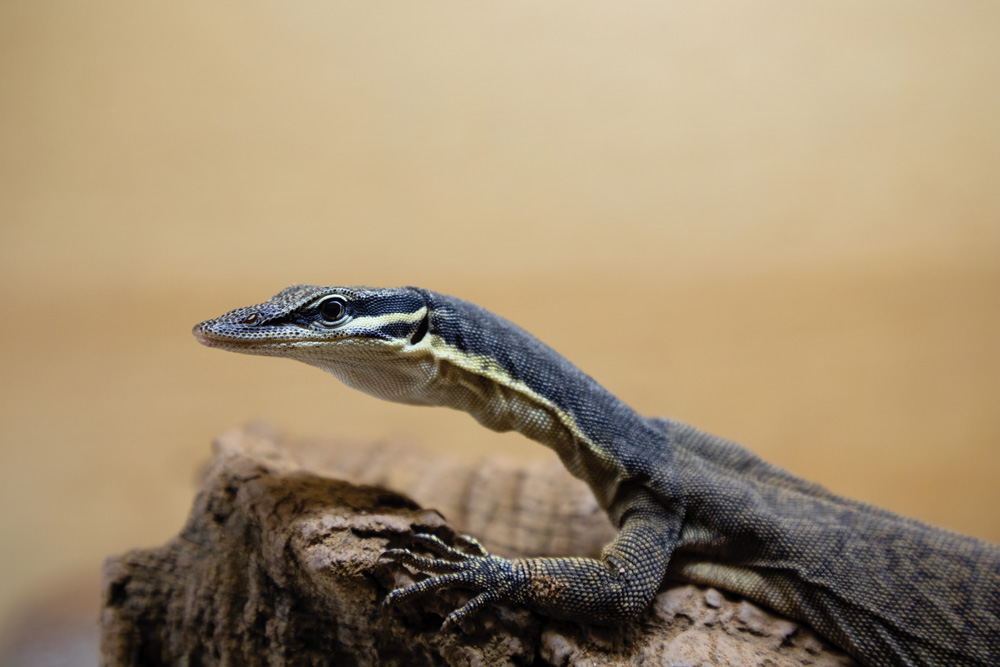Kimberley rock monitors are dwarf monitors with similar markings, body shapes, and even behaviors of much larger monitor lizards but happen to be a more handleable size.
The Kimberley rock monitor (Varanus glauerti) is a rock-dwelling dwarf monitor endemic to northern Australia. This semi-arboreal desert varanid has a penchant for hanging upside down and curiously exploring its surroundings. With a long elegant neck, beautiful diamond patterns and color variations, flat snout, and the capability to flatten themselves to fit into narrow rock crevices, your Kimberley rock monitor will bring you years of joy and fascinating behaviors to observe.
Where To Buy a Kimberley Rock Monitor
Kimberley rock monitors are slowly becoming more widely available in the United States. They are easier to find in Australia and the UK, but American reptile breeders are working on new generations of captive-bred Kimberley rock monitors. At the time of writing, Kimberley rock monitors are harder to obtain outside of specialty reptile breeding websites and major reptile expos. Given their rarer availability, Kimberley rock monitors are more expensive than more readily available dwarf monitors such as Ackies.
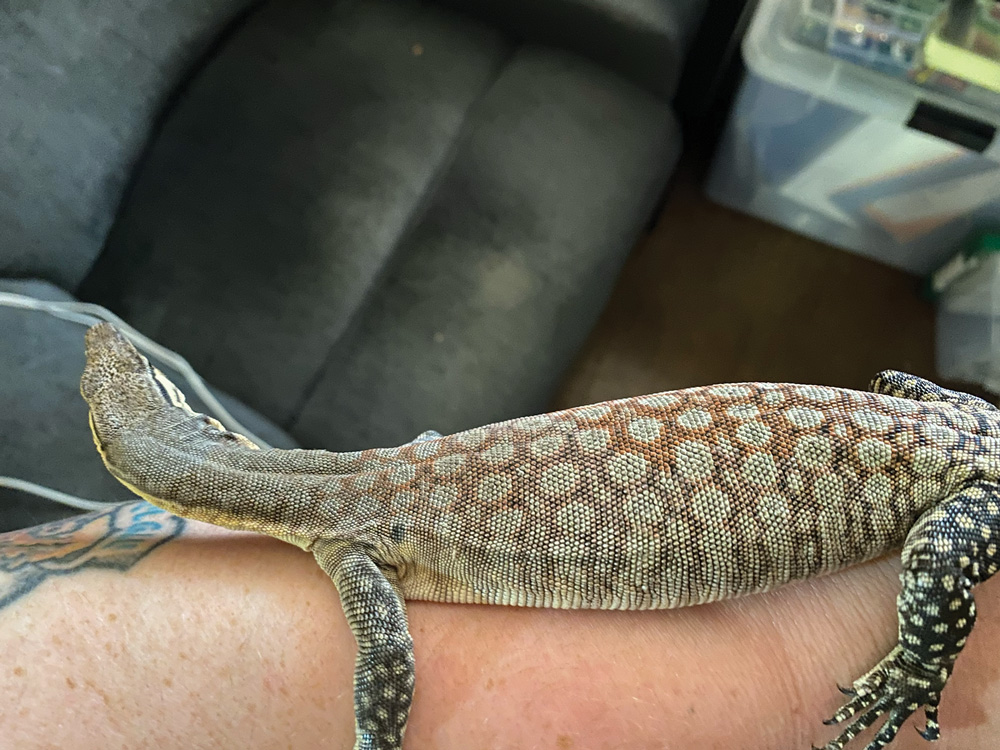
A trusting and social Kimberley rock monitor will purposely seek out interaction with you. Photo by Rachel Presser
Kimberley rock monitors are dwarf monitors with similar markings, body shapes, and even behaviors of much larger monitor lizards but happen to be a more handleable size.
Hatchlings are around 6-7” long. Juvenile Kimberley rock monitors will grow to 10-24” long, with most of that length being their tails. Adults usually top out around 32” at the short end but larger Kimberley rock monitors have grown up to 48” snout to tail. When well-cared for in captivity, Kimberley rock monitors live about 15-20 years.
Kimberley Rock Monitor Enclosure
On account of their smaller size relative to other monitor lizards, Kimberley rock monitors are excellent pet monitors for keepers who live in small spaces. They still require a sufficiently-sized enclosure once they reach their adult length, but they don’t need a complex outdoor setup or an entire room in your home.
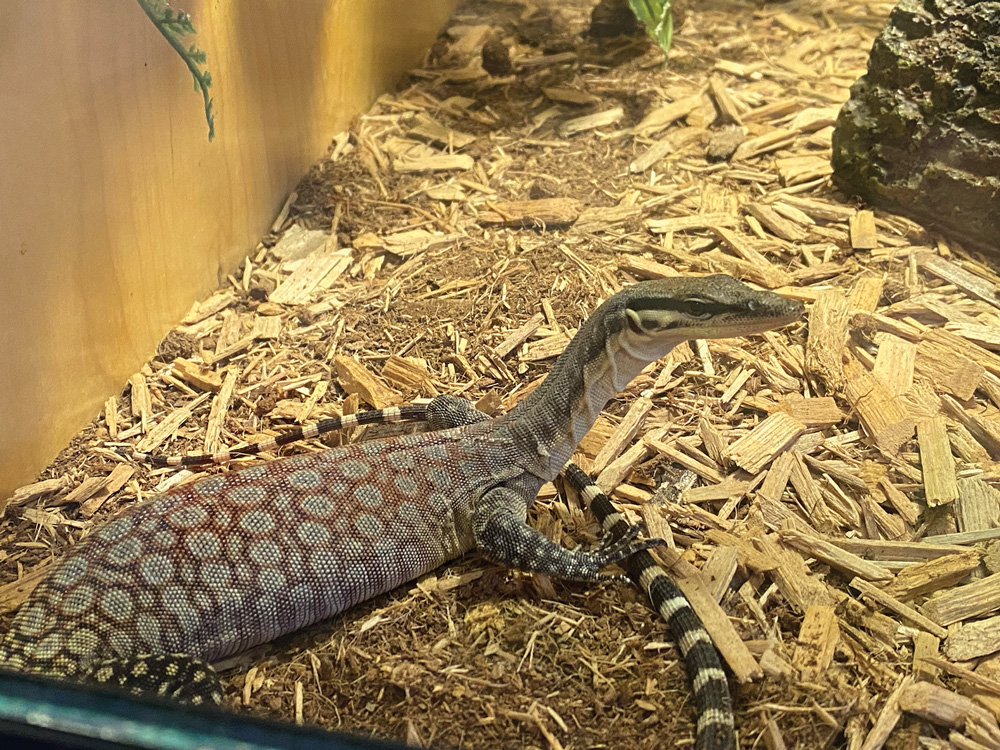
The author has spent many months socializing her Kimberley rock monitor. Photo by Rachel Presser
A PVC or wood cage is recommended since they hold heat more efficiently than glass. The enclosure should be at least 48” wide, 24-36” deep, and 36-48” high or taller to house a Kimberley rock monitor from a baby to adult size. This species does not require a transitional habitat, but some keepers prefer to use them.
Kimberley rock monitors like to dig, but if the substrate is too soft, they can get torsion on their claws. Organic dirt, coconut fiber, peat moss, orchid bark, and forest bark are excellent substrates. Ideally, there should be a bottom layer with soft substrate like organic dirt and/or coconut fiber with a hard layer on top like orchid bark or Eco Earth Forest Floor. Substrate should be changed at least once a month.
Lighting and Temperature For The Kimberley Rock Monitor
To best emulate their natural habitat, Kimberley rock monitors need at least one basking bulb and one UVB bulb. The UVB should be at least 7.5, but 10.0 is best. Depending on the manufacturer, the UVB bulb should be changed every six months to a year, even if the bulb has not burnt out yet.
The basking bulb strength depends on the size and layout of the enclosure. It should be 100W at minimum, or have multiple 40W and 75W bulbs in an array to create a heat gradient. Larger enclosures, particularly those with more height, should have a 160W basking bulb to generate the heat Kimberley rock monitors require if it’s a single clamp lamp or fixture setup. If your lizard is uninterested in eating or seems lethargic, you likely need a basking bulb with higher wattage or to create a wider gradient with multiple bulbs.
Kimberley rock monitors need at least 90°F (32°C) to be voracious and active lizards. 100-120°F (37-48°C) is the ideal basking temperature for this species. Some keepers recommend going as high as 130°F (54°C) but pay attention to whether your Kimberley rock monitor is panting. They need high temperatures and a heat gradient, but panting is a sign they’re too hot. If this is the case, you need a weaker basking bulb or to run it for less time.
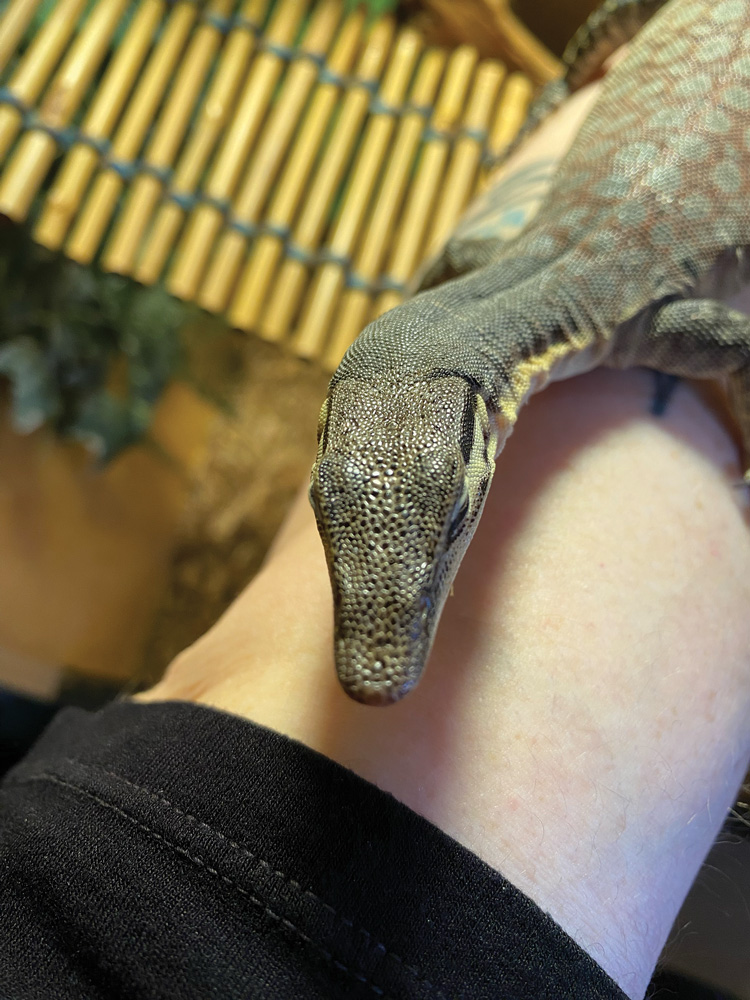
The Kimberley rock monitor is a small monitor native to Australia. Photo by Rachel Presser
Ideally, the bulbs should run for 12 hours per day. Smart plugs with a corresponding app can easily program the bulbs’ daily duration, some can even be tuned with local sunrise and sunset to provide more naturalistic indoor lighting.
Feeding
Kimberley rock monitors are primarily insectivores but they will eat other foods. Babies will eat crickets, small dubia roaches, grasshopper nymphs, waxworms, and other small insects. Juvenile and adult Kimberley rock monitors can eat larger prey such as adult dubias and grasshoppers, rat and mouse pups, and hornworms.
Both babies and adults will eat more readily-available sources of protein like hardboiled eggs, ground turkey, and chicken gizzards. Because Kimberley rock monitors have fairly small mandibles and don’t rely on their teeth as much as larger varanids, smaller and softer prey is better for their digestion and overall nutrition. It is best to dust their food with a calcium supplement in regular feedings, and a weekly dusting of multivitamin with D3.
Babies should eat daily. Juveniles (around 1-2 years old) can eat every other day. Adults can eat 3-4 days per week depending on the size of the lizard and the feeding.
Water and Hydration
As is the case with most monitors, Kimberley rock monitors need a water dish for drinking and assisting with skin sheds. The water should be changed daily.
Their habitats also need daily misting to avoid dehydration, especially if you are raising your Kimberley rock monitor in a drier climate or household. Running a humidifier in the room is a better option for this species than an automatic mister or fogger. Humidity of at least 50% should be maintained. If it’s too dry where you live, a misted hide can help.
Handleability and Temperament
Kimberley rock monitors are one of the most wonderful pet monitors you can get when it comes to their temperament. Given their easily handleable size and the amazing personalities they can develop with proper socialization, Kimberley rock monitors will certainly become a more popular pet in the coming years.
Kimberley rock monitors can be skittish, especially when they’re getting used to you and a new home. However, they will become more handleable with time and care. These small varanids can be socialized from babies and juveniles easily, but even an adult can become tame with regular and positive interaction from its keeper.
While they take time to build trust with you, Kimberley rock monitors are extremely unlikely to bite humans which makes them a good monitor lizard to have around children. A trusting and social Kimberley rock monitor will purposely seek out interaction with you. They like to climb on their humans, perching on their shoulders like a pirate parrot, and will even nuzzle your hands and place their clawed toes on you like a hug.
Care and Enrichment Tips
Being semi-arboreal lizards, Kimberley rock monitors love to climb. One of their most fascinating behaviors comes from the “rock” in their name: they will flatten themselves to squeeze into tight spaces. Their bodies form a “dinosaur pancake” of sorts as they use their flat, pointed snouts to propel themselves forward with their limbs tucked inward similar to how water monitors swim.
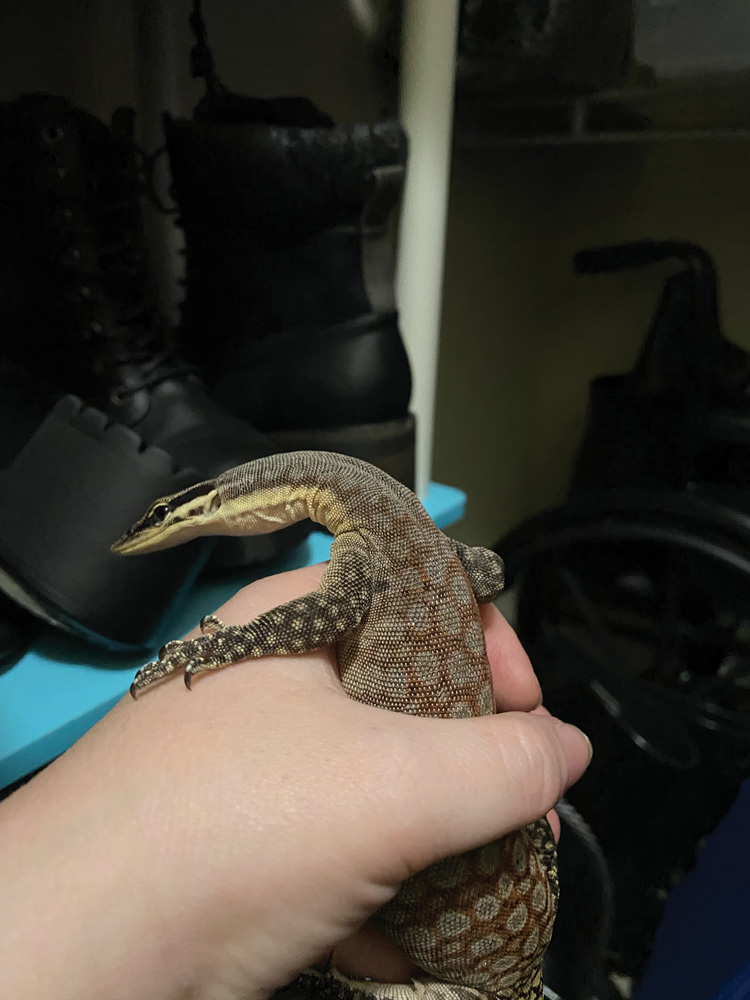
Kimberley rock monitors are excellent pet monitors for keepers who live in small spaces. Photo by Rachel Presser
Their enclosures need lots of different surfaces to climb, in addition to branches and rock ledges for basking and exploration. Having multiple textures to climb and explore provides mental stimulation and helps develop different muscle groups. You may need to experiment with different foods, decorations, and enrichment toys based on your monitor’s preferences, but they love to chase live bugs like grasshoppers and dubia roaches. This makes these bugs just as effective for enrichment as they are for nutrition. By providing an enriching habitat, your monitor will be happier, healthier, and more social.

